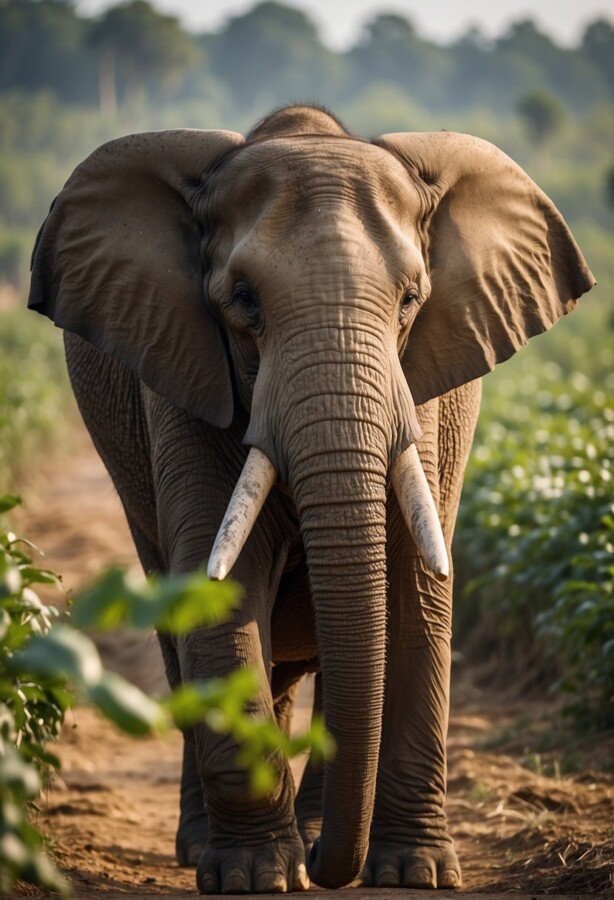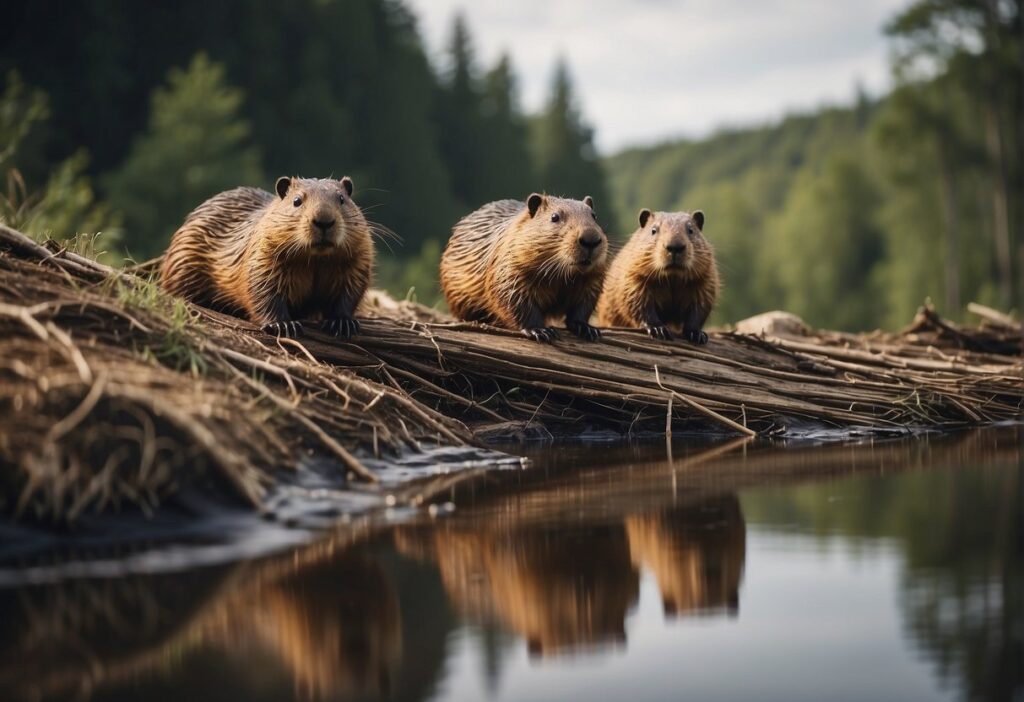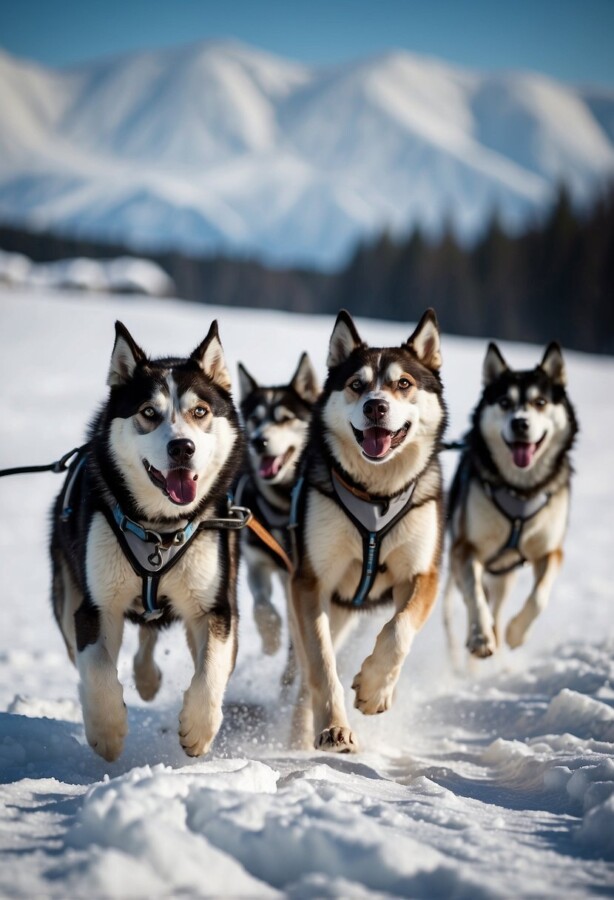The animal kingdom is abundant with species that exhibit remarkable work ethics, many of which contribute significantly to their ecosystems and human society. Service animals, such as guide dogs, perform critical roles that enhance the lives of individuals with disabilities, offering both companionship and functional support.
On farms, creatures like oxen and horses have long been indispensable for their strength in plowing fields, gathering food, and transporting goods, demonstrating the symbiotic relationship between humans and working animals.
Among the hardest workers are ants and bees, pivotal in maintaining ecological balance through pollination and soil aeration. These tiny laborers work tirelessly: ants coordinate in sophisticated colonies, while bees pollinate many plant species, facilitating the production of seeds and fruits. Their collective diligence underpins a thriving environment, underscoring the intrinsic value of hard work across animal species.
The Industrious Ants

Ants are the epitome of hardworking insects, esteemed for their tireless labor and the complex societies they build. In their multitudes, these creatures operate in highly efficient ant colonies that showcase extraordinary levels of teamwork.
Traits of Ant Legions
- Cooperative: Unity is key; each ant has a role that benefits the colony, from nurturing the young to foraging for sustenance.
- Structured: Colonies are formed with intricate tunneling systems within the soil, showcasing an incredible knack for natural engineering.
Impact on Ecosystem
- Soil Aeration: Their tunneling ventilates the soil, promoting plant growth.
- Seed Dispersal: Many plants rely on ants to spread their seeds.
Ants as Predators
- Many species act as natural predators, helping to control pests.
In summary, ants’ diligence as hard workers is undeniable, from their unyielding quest for resources to their significant role in maintaining ecological balance.
Honeybees

Honeybees (Apis species) worldwide honey bees represent a group of highly efficient pollinators crucial for ecosystem health and agriculture. These social insects live in well-organized hives that produce honey and beeswax, essentials for survival.
- Honey Production: Honeybees collect nectar from flowers, which they convert into honey through regurgitation and evaporation, serving as their primary food source during colder months.
- Beeswax Creation: Produced from glands in the worker bee’s abdomen, beeswax forms the hive’s structure, crafting the hexagonal cells that store honey and house their larvae.
Worker bees communicate via a “waggle dance,” a sophisticated method of signaling the location of food sources to their hive mates. Beyond their roles in the hive, honeybees are pivotal in pollinating a vast array of plant species, directly influencing crop yields and biodiversity. They offer a remarkable example of nature’s intricacy and interdependence.
Strength of Oxen

Oxen, robust animals pivotal in agriculture, have been integral to farming due to their formidable strength. These animals specialize hard-working animal, in arduous tasks, such as plowing fields and hauling heavy loads, often surpassing several times their body weight. Not only are they among the hardest working animals on the farm, but their endurance and patience in repetitive tasks make them invaluable for sustained labor.
- Physical Attributes: Oxen possess a strong, muscular build appropriate for rigorous farm work.
- Strength Capacity: Capable of pulling heavy plows or loaded wagons.
- Role in Agriculture: Vital for tasks like tilling soil, transporting harvests, and other labor-intensive activities.
Their contribution to agriculture goes beyond muscle power; oxen have a temperate demeanor, allowing farmers to work with them effectively over long periods. This synergy of strength and disposition solidifies their status as agricultural mainstays.
The Grand Elephants

Elephants are among nature’s most diligent workers. Notably, their bodies can weigh up to 6,000 kilograms (kg), supporting their various tasks, from modifying landscapes to protecting their herds.
- Intelligence: These mammals exhibit sophisticated problem-solving and memory abilities, showcasing their high intelligence.
- Tasks: With remarkable strength, elephants play crucial roles in ecosystems, such as creating water holes and dispersing seeds.
- Hardest Workers: Representing steadfast dedication, elephants tirelessly journey across vast terrains, contributing substantially to their habitats.
The Reliable Donkeys

Donkeys have long been recognized for their indispensable contributions to agricultural and rural economies. They possess remarkable strength and shoulder burdens in various settings—from farmwork to transport.
Capabilities and Characteristics
- Strength and Endurance: Vital for carrying heavy loads in rugged terrain.
- Low Maintenance: They thrive on minimal care, attributing to cost-effectiveness.
Economic Value
Recent trends indicate a surge in the valuation of donkeys, mirroring heightened appreciation for their vital role in human livelihoods.
Contributions to Human Activity
- Transporting essentials like water and food in resource-limited areas.
- Complementing human labor reduces the need for mechanized alternatives.
Table: Donkey Attributes
AttributeDescriptionLifespanConsistently lengthy, reflecting hardinessTemperamentCalm and reliable, facilitating training and handling
Their symbiotic relationship with humans underscores donkeys’ status as one of the most reliable work animals globally.
Termites

Termites are exemplars of tireless industry within ecosystems. Their nests, which involve complex construction processes, are marvels of engineering that can endure for decades. As social insects, termites utilize a division of labor, where specific roles are clearly defined—some forage for sustenance, while others specialize in nest construction and maintenance.
Nest Construction: Termite mounds are constructed from soil, saliva, and other animal feces together, creating sturdy structures that can regulate temperature and humidity.
- Ecosystem Importance: Termites enhance soil fertility by breaking down cellulose, which is abundant in wood. They’re fundamental to nutrient cycling in ecosystems such as forests and wetlands.
- Hard Workers: Known for their relentless work, termites constantly repair and expand their elaborate nests.
Their role in ecosystems is crucial, contributing to decomposition and soil formation. Despite their scientific name and perceived notoriety as pests, these hard-working insects fulfill essential tasks that significantly impact their habitats.
See Related: Are Bears Color Blind? Unveiling the Truth About Their Vision
Horses

Horses (Equus caballus) are versatile working animals with significant roles in various human activities. As pack animals, they display strength and endurance, often carrying loads in areas where vehicles may not be practical. On farms, horses contribute by plowing fields and transporting goods. Their aptitude extends to serving as therapy animals, assisting individuals with disabilities, fostering psychological and physical rehabilitation.
Working Roles
- Pack Animals: Carrying supplies in rugged terrain
- Farm Work: Plowing and pulling carts
- Service: Therapeutic riding for people with disabilities
Horses have been domesticated since around 2000 B.C., making them one of the earliest animal partners in human history. Their robust build enables them to perform labor-intensive tasks efficiently. Riding horses is not just recreational; it’s a form of exercise and bonding that enhances their physical health and ability to work alongside humans.
Camels: Masters of the Desert

Camels are epitomes of hard work in desert terrain. These animals have adapted to some of Earth’s most challenging environments, enduring extreme temperatures, water scarcity, and sparse vegetation. Their physiological adaptations, such as unique hump storage of fat, enable them to go long periods without food or water.
Hard-working Characteristics:
- Resilience: Camels can carry heavy loads over long distances, making them indispensable for humans living in desert regions.
- Load-bearing Capacity: These sturdy creatures can carry up to 25% of their body weight while trekking across arid landscapes.
Through their incredible work ethic alone, camels facilitate transportation and trade in desolate areas where other modes of conveyance flounder. Their role in supporting human existence in harsh conditions cannot be overstated, rendering them true masters of the desert.
Beavers as Natural Engineers

Ecologists recognize beavers as ecosystem engineers due to their remarkable ability to modify their surroundings for habitation. Central to their engineering feats are their dams, intricate structures built from cut trees, vegetation, and mud. These dams serve critical functions:
- Regulating water flow: By constructing dams across streams, beavers create water pools to prevent floods downstream and maintain the water table during dry spells.
- Constructing lodges: Within the wetlands, beavers build lodges as living quarters, which offer protection against predators.
Their activities as architects of human beings in the wild go beyond mere survival—they foster biodiversity:
- Wetlands creation: These habitats are hotspots for life, supporting many species, including fish, birds, and amphibians.
- Ecosystem benefits: The ponds and wetlands, products of beaver engineering, act as natural filters, improving water purity and aiding in carbon storage.
Their contribution towards altering landscapes underlines beavers’ substantial impact on ecosystem health and resilience.
The Aerial Acrobatics of Hummingbirds

Hummingbirds exhibit remarkable flight abilities unparalleled by other avian species. They can hover in midair by rapidly flapping their wings up to 80 times per second, which consumes immense energy. To fuel their high-octane lifestyle, these birds require frequent nectar intake, which is a potent energy source. During feedings, their aerial skills facilitate pollination as they transfer pollen from one bloom to another. Significant aspects of their flight include:
- Wing Rotation: Hummingbirds possess the unique ability to rotate their wings in a full circle, enabling them to fly in all directions — forward, backward, and even upside down.
- Hovering: Their hovering precision is facilitated by complex muscle movements and wing adjustments, which allow for sustained stationary flight to access nectar while exerting minimal energy.
- Energy Efficiency: Despite high-energy demands, hummingbirds manage their output adeptly. Their small size and fast metabolism necessitate continual feeding, which their rapid flight abilities support.
- Pollination Agents: As they dart from flower to flower, hummingbirds play a crucial role in pollination, ensuring that various plant species can reproduce and thrive.
Sled Dogs: Endurance in the Cold

Sled dogs exhibit remarkable endurance in Arctic conditions, woven into the cultural fabric of regions where humans and canines collaborate. Breeds like the Siberian Husky and Alaskan Malamute have historically shouldered burdens across icy expanses.
Adaptations for the Cold:
- Thick double coats
- Tough paw pads to prevent frostbite
- Blood circulation mechanisms maintaining extremity warmth
Sustaining a team ethos, these dogs harness a collective strength, enabling formidable tasks, such as hefting loads exceeding hundreds of pounds. Meticulously bred for service, durability, and teamwork, their stamina is pivotal for tasks ranging from transportation to competitive dogsled racing. Sled dogs’ service extends beyond labor; they embody companionship and a mutual survival instinct that underlines their critical role in Arctic life.
Endurance Highlight:
- Long distances: over 20 miles
- Large loads: up to 1,000 pounds (brief distances)
Sled dogs are the epitome of resilience, molded by nature and nurture to navigate and serve in the world’s harshest climates.
Mules: The Hybrid Workers

Mules, the offspring of a male donkey and a female horse, are lauded for their enduring work ethic and physical prowess. Strength and surefootedness render them invaluable for a variety of labor-intensive tasks.
- Utilization: Mules are adept at plowing fields, hauling heavy weights, and serving as steadfast transportation.
- Training: The breaking process, which takes months, accustoms them to harnesses and commands and yields long-term farm utility.
While exhibiting superior traits from both equine parents, mules cannot reproduce, ensuring their lineage requires continuous cross-breeding.
TraitBenefitDurabilityIdeal for harsh climatesTemperamentPatient and level-headedLifespanOutlasts purebred horses
Mules have historically propelled westward expansion by transporting goods in areas inaccessible to wagons. Despite advances in mechanization, these stalwart hybrids remain relevant and respected in modern agriculture and pack services.
The Silk Production of Silkworms

Silk production is a testament to the diligence of silkworms, vital to both industry and textile sectors. These fascinating creatures, specifically the Bombyx mori, undergo strenuous labor to create one of the world’s most cherished fabrics. Upon hatching, a silkworm feeds on mulberry leaves, accumulating energy to spin a cocoon. This process is both culturally significant and industrially valuable, showcasing the intersection of tradition and modernity.
Key Process:
- Feeding: Exclusively on mulberry leaves.
- Spinning: Creating cocoons over 3-8 days.
- Harvesting: Cocoons processed into silk.
Harvesting silk involves unwinding the cocoon, a delicate procedure that ensures long, continuous filaments for high-quality textiles. With species such as the Mulberry, Muga, Tasar, and Eri silkworms, silk quality and texture variations emerge. Silkworms’ dedication to spinning their cocoons, coupled with human expertise in sericulture, culminates in a fabric that embodies resilience and elegance.
Reindeer: Adaptations for Survival

Reindeer are synonymous with endurance, particularly noted for their remarkable migrations. Covering up to 5,000 kilometers annually, they exhibit one of the animal kingdom’s most strenuous journeys, rivaling even the extensive travels of the Arctic tern.
Physical Adaptations:
- Fur: Insulating against piercing Arctic cold, their dense winter coats trap air for thermal protection.
- Hooves: Their broad, cloven hooves act as snowshoes, distributing weight to prevent sinking into soft snow or terrain.
Physiological Adaptations:
- Metabolism: Reindeer can alter their metabolism to conserve energy during scarce food periods.
- Eyes: Seasonal changes in eye color enhance light absorption, which is crucial for low-light vision in winter.
Behavioral Adaptations:
- Grazing Patterns: They forage for lichen, displaying a unique ability to digest this available winter food source due to specialized enzymes.
- Swimming: They are proficient swimmers, a vital skill for crossing water bodies during migrations.
These adaptations are not merely indicative of hard work but are a testament to the reindeer’s resilience, enabling them to thrive in extreme conditions.
Earthworms: Beneath the Soil

Earthworms are pivotal to soil health, engaging in vital processes that maintain ecosystem function. Their role in aeration improves the soil’s porosity, allowing roots to access more air and water. Through their constant movement, earthworms create channels within the earth that permit both drainage and root growth.
As agents of decomposition, these invertebrates break down organic matter, converting it to useful nutrients. Their digestive tract transforms decomposed material into castings rich in nitrogen, phosphorus, and potassium—key minerals for plant growth.
These hardworking creatures and soil engineers are unassuming heroes whose constant labor beneath our feet sustains the fertility and structure of their terrain.
See Related: Easy Plant Propagation Techniques to Start Today
Salmon: The Lifelong Journey

Salmon embark on a remarkable odyssey marked by evolutionary adaptations and stages. Their life cycle is characterized by migration between freshwater rivers and the ocean, showcasing a resilience crucial for survival and the ecosystems they traverse.
Life Cycle Stages:
- Birth: Hatching in riverbeds
- Freshwater Stage: Development in natal rivers
- Migration: Transition from freshwater to ocean
- Ocean Life: Growth to adulthood in marine waters
- Spawning Migration: Return to birth rivers to reproduce
- End of Cycle: After spawning, adults typically die
These stages ensure the transfer of ocean nutrients to riverine environments, fortifying the broader ecosystem. The journey of salmon illustrates the intricate link between marine and freshwater habitats, making wild animals and their migratory patterns emblematic of nature’s interconnectedness.
Bowerbirds: Artistry and Mating

Bowerbirds distinguish themselves and attract females through complex mating rituals involving the construction of ornate structures. These avian architects meticulously craft bowers—display nests not used for rearing young but solely for courtship. The male bowerbird invests significant energy in collecting and arranging diverse objects, ranging from vivid berries to man-made items, to adorn his bower, enhancing its appeal to potential mates.
Key mating ritual elements:
- Construction: Elaborate bowers are created using twigs, bones, and rocks.
- Decoration: Reflective and colorful items are curated to entice females.
- Illusion: Some species engineer optical illusions within their bowers to captivate mates.
- Evaluation: Females inspect bowers based on aesthetic and structural criteria before selecting a partner.
This ritual underscores a unique intersection of instinct and learned behavior, underpinning the species’ reproductive success. The bowerbird’s mating endeavors in such a way may reflect not just the survival of the fittest but the survival of the most creative.
Emperor Penguin: Family and Resilience

Emperor penguins, endemic to Antarctica’s harsh climate, are celebrated icons of familial dedication and survival. In this unforgiving environment, they employ a remarkable breeding and child-rearing system that underscores their resilience.
Breeding Cycle:
- Mating: Emperor penguins find their mates promptly to ensure successful breeding within their strict seasonal window.
- Egg Incubation: Once a female lays a single egg, the responsibility shifts to the male, balancing the egg on his feet under a special flap of skin called a brood pouch.
Survival:
- Temperatures and Diet: These birds endure temperatures plummeting to -60°C and rely on their diet of fish, krill, and squid, which they hunt during deep dives under thick ice.
- Family Structure: The cohesiveness of the family unit and colony enables the emperor penguin to survive and thrive in this extreme ecosystem.
Despite Antarctica’s severe conditions, emperor penguins exemplify the power of adaptation and the strength of togetherness. Their commitment to peaceful nature and family is pivotal in their endurance, fostering a resistant community equipped to withstand the continent’s challenges.
Related Resources:
- Most Interesting Animals in the Midwest
- Incredible Animals With Short Attention Spans
- The Most Fascinating Animals with Stripes: A Complete Guide


